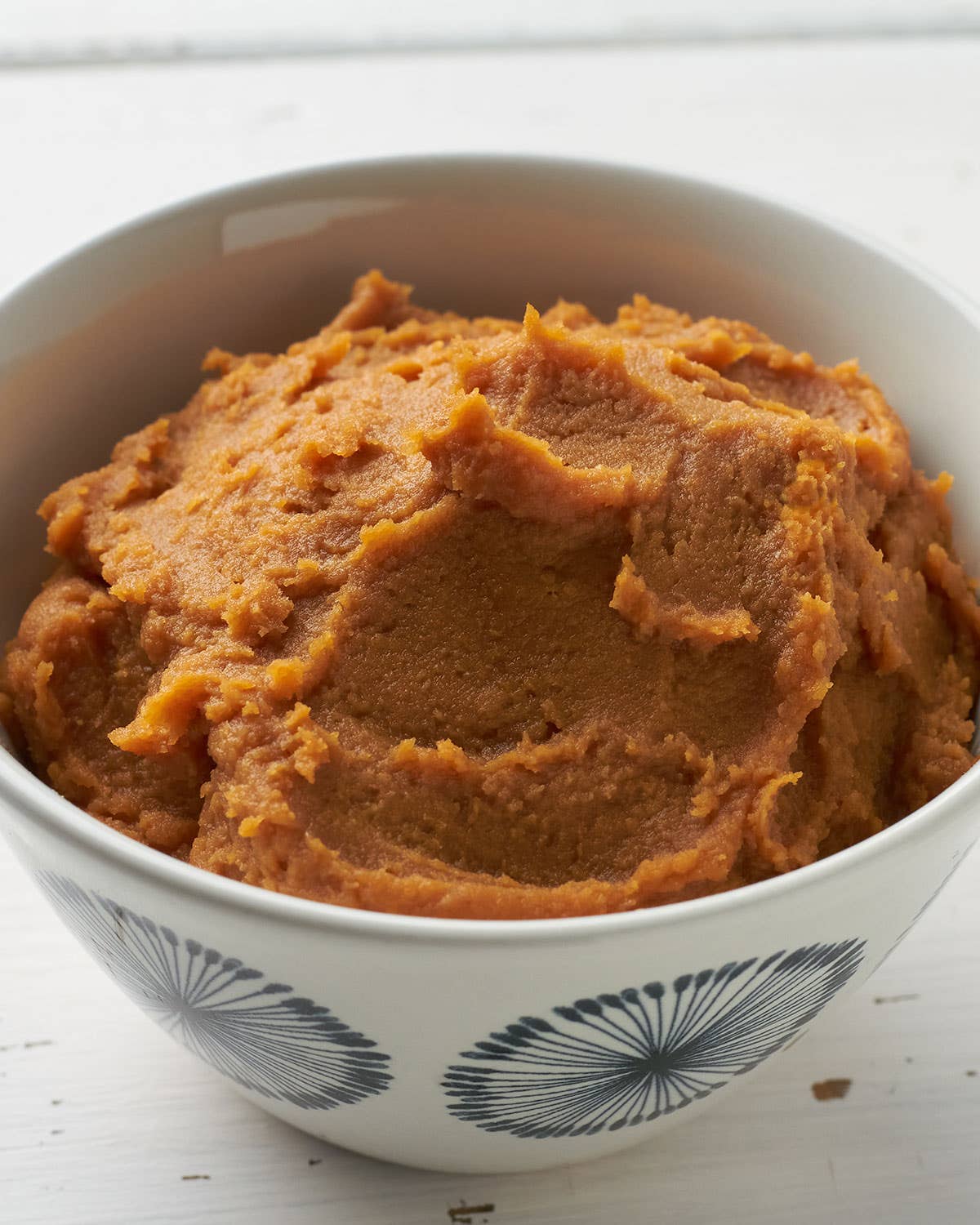Magical Miso
This sweetly pungent fermented soybean paste is at the very heart of traditional Japanese cooking.

This feature was originally published in our May/June 1998 issue.
Miso, that elemental paste of fermented soybeans, was once made in most Japanese homes, both in the cities and in the countryside. Recipes and procedures were well-guarded family secrets, the process took months, and no two batches of miso would ever taste the same—due to varying proportions of salt to soybeans, the common (but not essential) addition of rice or barley, and the length of fermentation. Even the soil in which the soybeans were grown could make a difference. Miso, as a result, became a source of great family pride. "Temae miso desuga," one would say—meaning "I don't want to boast about my miso, but..."
Though my own family did not make miso at home, it was indispensable to us nonetheless, as it was (and still is) in all Japanese kitchens. Misoshiru, or miso soup, is served almost every day—either with rice and pickled vegetables as a complete (if frugal) meal, or on its own as the standard breakfast. I use miso as a base for all kinds of sauces and dressings, and like many people, I believe it to be essential when braising or grilling fish, especially strong-flavored mackerel. And I wouldn't cook beef without it.
Like tofu (soybean curd), miso is high in protein. Unlike tofu, whose greatest selling point is its ability to soak up the flavor of whatever else it is cooked with, each kind of miso has its own rich, complex flavor and its own purpose—whether it be to enrich a broth or stock, to season a sauce or marinade, to work as a pickling agent or preservative, or to stand on its own, spread on vegetables or layered into casseroles. Miso is healthy and versatile and simple in composition, but its real magic comes from the fact that it has the ability to transform—even to elevate—other ingredients onto a different level altogether. That's what puts miso at the heart of Japanese cuisine.
Unfortunately, miso can be confusing for anyone who hasn't grown up with it. The problem is twofold: First of all, it has no Western counterpart, either in composition or versatility, so the average non-Japanese cook has no frame of reference for it. The second problem is that there are several types of miso—the three basic categories being komemiso, mugimiso, and mamemiso (rice, barley, and straight soybean miso, respectively), and each encompasses several different varieties.
Japan's miso tradition began around the seventh century a.d. Miso seems to have evolved from both chiang, a soybean paste that Buddhist monks brought from China, and jang, a similar soybean product that Korean farmers introduced into Japan's countryside. With the exception of a rustic farmhouse version, miso was made just for the nobility (and solely by monks) until the tenth century. Gradually, soybeans became more widely available, and the making of miso slowly spread to all levels of society. Though it had reached staple status throughout Japan by the 1300s, miso continued to be produced at home until the 18th century, when samurai families, once employed by now-disenfranchised feudal lords, founded the miso-making industry.
Today, much of the miso made in Japan comes from giant factories. According to Eddie Fujima, a consultant for Marubeni America Corporation in New York City—which exports American soybeans to Japan—some 50 of Japan's 1,355 miso makers control 90 percent of the market. Most of these use soybeans imported either from the United States or from China. Miso connoisseurs, who are adept at detecting an inferior product, seek out small miso breweries—the kind that are painstakingly preserving old-fashioned techniques and regional miso styles.
Late last year, I took the train from Tokyo to Honjō, about 75 mils northwest of the city. From there, I caught a bus to the tiny village of Kamiizumi-mura, and specifically to Yamaki Jōzō—a miso factory that functions, at least in part, i the traditionally manner. (Yama means "mountain," as in a mountain of soybeans or miso; ki stands for Kitani, the name of the family that owns the company; and jōzō means "brewery.") Kazuhiko Morita, the brewery's director, neatly attired in a starched white work jacket and white hat, greeted me with a deep bow and a smile at the brewery door. Immediately, he launched into a passionate explanation of the company's history, informing me that it had been making miso (the three basic types as well as a few specialty styles), soy sauce, and tofu since 1902. In the 1960s, the organization had switched to using raw materials most of them grown domestically. And though the company's philosophy had remained traditional, he added, production had become partially automated in the mid-1980s. When he stopped to take a breath, I interrupted and asked to se how miso is made. "Okay!" he agreed, and we were off.
Yamaki is a small brewery—its annual output is about 400 tons—and only one type of miso is made at a time. I turned up on the third day of akamiso (red miso, which in this case refers to a type of rice miso) production. On the first day, rice had been soaked, steamed, and then inoculated with kōjikin, a spore of mold (Aspergillus oryzae) that triggers fermentation. It had been fermenting for about 48 hours since then, producing enzymes that would later help break down the soybeans.
The first room we visited was devoted to the soybeans. We stood on a high platform along one of two gigantic steel pressure cookers. When we opened the lid, a vigorous swirl of steam filled the entire room. Once the steam, had evaporated, my guide scooped up a lovely. yellow mound of soft soybeans. "cooked beans should be cooled quickly," he explained, as he pushed a few burtons commanding the cooker to turn and empty all 5,300 pounds of its contents onto a conveyor belt. Next, we peeked into the hot, humid rice room, where eight inches of fuzzy kōji, or inoculated rice, covered the floor. Two conveyor belts, one carrying the cooled steamed soybeans, the other transporting the kōji, come together in a third room. There, the grain and beans are mixed with sea salt and spring water, then pressed through a big machine resembling a meat mincer. Next the mixture is packed into huge cedar barrels. A plastic sheet is stretched over the top and weighted with stones to force excess liquid to the top and help create a safe, airtight environment. Then the miso is left to ferment until the summer.
In June or July, Morita-san told me, the miso is moved to another set of barrels—exposure to oxygen enhances fermentation—and allowed to develop for a few more months. In November, the miso is stirred and transferred yet again so that the light brown color will be evenly distributed. Shortly after that, Morita-san tastes the miso to determine how much longer it should be left to mature. He looks for a dark brown color and a mild flavor; if it's too salty at this point, eh said, it is not ready. Morita-san claims to have ruined a batch of miso only three times in 20 years, but he also told me that his loyal (and picky) customers have no qualms about pointing out even the slightest changes. Yamaki's miso is neither dosed with alcohol to stop the fermentation process nor passteurized (as many misos are). Instead, when Morita-san believes his miso to be ready, he packs it into refrigerated steel vats. This way, all its natural yeasts and lactic acids (which are believed to aid in digestion) remain active, resulting not only in a more nutritious miso, but in one more complex in flavor.
At the end of my tour, Morita-san packed me a container of one of the brewery's specialty misos—genmai-namamiso, which is made with brown rice instead of the usual white.
A week later, after I'd written him a letter thanking him for his hospitality, he offered me an even better gift: "Would you like to make your own miso at home?" he inquired by fax. Upon receiving my enthusiastic reply, he sent me two pounds of kōji and detailed instructions. I bought the finest soybeans I could find, a five-quart enamel container with a fitted lid, and four pounds of stone weights. I soaked and cooked my soybeans, mixed them with Morita-san's kōji, then mashed them with sea salt and water. I packed it all into the pot, set it in my basement, and prayed for the growth of "good" miso bacteria. Four months later, I cautiously opened the lid. At once, I recognized the sweet rice fragrance that had permeated the brewery. The miso's surface had acquired a lush dark brown hue, and to my relief, there were no "bad" bacteria. I stirred up my miso, then set it aside again. In November, Morita-san called, asked me how my miso was behaving, and suggested that it was probably ready. With that, I gathered some small containers, made a mental list of the lucky few I would share my miso with, and returned to the basement. I gave my miso several big stirs to even out the color, then I had a taste. "Temae miso desuga..."
Keep Reading
Continue to Next Story










